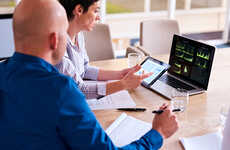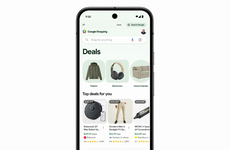
Google is Here to Help Retailers Stand Out
Riley von Niessen — November 6, 2020 — Business
References: google
Radical retail transformation has been an underpinning of 2020. In the past six months, retailers have committed to new safety protocols and expanded shopping formats to enable more convenient shopping options. These newly expanded shopping formats, like curbside, ecommerce, and click-and-collect, have become a significant share of retailer's earning reports.
Consumers are embracing these new shopping experiences, which we anticipate will continue into the holidays and beyond. In fact, one third of consumers believe that their shopping behaviors have shifted permanently. So how can retailers address the new shopping habits that have emerged to win this holiday season and beyond?
Google partnered with Boston Consulting Group to help retailers adapt and react to this new path to purchase. There are three winning strategies to meet shopper expectations and achieve business objectives: show up throughout the consumer journey, capture demand as it rises, and showcase retailer value.
Show up throughout the consumer journey
Consumers are open to shopping inspiration, with up to 30% of demand inspired by something a shopper saw, watched or read something about— rather than researching to fulfill a specific shopping need. In order to make the most of rising shopping demand for the holiday season, a retailer’s media and website strategies need to be optimized for the occasion.
Use Google Trends and Rising Retail Categories to identify trending or seasonal categories that may prompt shopping inspiration to inform your retail media strategy.
On retail websites, creating gift guides for holiday shopping and offering bundled products streamlines the path to purchase. Even everyday purchases in discretionary categories can be one to two-month long journeys, so offering complimentary products or services can increase basket size when shoppers are ready to purchase.
Capture demand as it rises
Winning a spot in the coveted consideration set is critical, and it happens quickly. Retailers that do not make it into this initial consideration set have lost in 80-90% of cases. Focusing on a seamless digital path to purchase is table stakes to be a part of the 2020 consideration set. In order to generate demand and make the consideration set, retailers must engage with key shopping audiences and automate for business outcomes.
Engaging with these key shopping audiences lays the foundation to engage with first-party, similar audiences, life events and affinity shoppers to maximize media efficiency. Craft a creative messaging strategy to personalize for the individual consumer preferences to drive engagement.
Automation will align your media strategy to real-time signals with machine learning to keep up with customer demand and optimize for the right business results.
Showcase retailer value for customers
With 43% of people in the US concerned about personal finance, even everyday expenses are scrutinized closely. One in three consumers have bought online from a category for the first time, which is likely to continue through the holiday timeframe. Promotions and loyalty programs are highly valued to aid consumer confidence in their purchase decisions.
In order to showcase their value, retailers can implement local campaigns, free product listings, Google Shopping and keep promotions up-to-date. Local campaigns allow shoppers flexibility to research online and find local inventory levels to consolidate shopping trips, along with curbside pickup options. Meanwhile, free product listings and Google Shopping ads empower shoppers to find price comparisons and ensure value, and retailers can ensure their promotions are updated regularly to stay competitive in the marketplace for price-conscious consumers.
Read more on how the pandemic may impact holiday shopping, along with winning strategies for a successful 2020 holiday season.
Researched by Google and Boston Consulting Group
Written by Jane Butler, Kevin Fried, Sarah Travis, and Ted Buell
This article is sponsored
Image Credit: Shutterstock
Consumers are embracing these new shopping experiences, which we anticipate will continue into the holidays and beyond. In fact, one third of consumers believe that their shopping behaviors have shifted permanently. So how can retailers address the new shopping habits that have emerged to win this holiday season and beyond?
Google partnered with Boston Consulting Group to help retailers adapt and react to this new path to purchase. There are three winning strategies to meet shopper expectations and achieve business objectives: show up throughout the consumer journey, capture demand as it rises, and showcase retailer value.
Show up throughout the consumer journey
Consumers are open to shopping inspiration, with up to 30% of demand inspired by something a shopper saw, watched or read something about— rather than researching to fulfill a specific shopping need. In order to make the most of rising shopping demand for the holiday season, a retailer’s media and website strategies need to be optimized for the occasion.
Use Google Trends and Rising Retail Categories to identify trending or seasonal categories that may prompt shopping inspiration to inform your retail media strategy.
On retail websites, creating gift guides for holiday shopping and offering bundled products streamlines the path to purchase. Even everyday purchases in discretionary categories can be one to two-month long journeys, so offering complimentary products or services can increase basket size when shoppers are ready to purchase.
Capture demand as it rises
Winning a spot in the coveted consideration set is critical, and it happens quickly. Retailers that do not make it into this initial consideration set have lost in 80-90% of cases. Focusing on a seamless digital path to purchase is table stakes to be a part of the 2020 consideration set. In order to generate demand and make the consideration set, retailers must engage with key shopping audiences and automate for business outcomes.
Engaging with these key shopping audiences lays the foundation to engage with first-party, similar audiences, life events and affinity shoppers to maximize media efficiency. Craft a creative messaging strategy to personalize for the individual consumer preferences to drive engagement.
Automation will align your media strategy to real-time signals with machine learning to keep up with customer demand and optimize for the right business results.
Showcase retailer value for customers
With 43% of people in the US concerned about personal finance, even everyday expenses are scrutinized closely. One in three consumers have bought online from a category for the first time, which is likely to continue through the holiday timeframe. Promotions and loyalty programs are highly valued to aid consumer confidence in their purchase decisions.
In order to showcase their value, retailers can implement local campaigns, free product listings, Google Shopping and keep promotions up-to-date. Local campaigns allow shoppers flexibility to research online and find local inventory levels to consolidate shopping trips, along with curbside pickup options. Meanwhile, free product listings and Google Shopping ads empower shoppers to find price comparisons and ensure value, and retailers can ensure their promotions are updated regularly to stay competitive in the marketplace for price-conscious consumers.
Read more on how the pandemic may impact holiday shopping, along with winning strategies for a successful 2020 holiday season.
Researched by Google and Boston Consulting Group
Written by Jane Butler, Kevin Fried, Sarah Travis, and Ted Buell
This article is sponsored
Image Credit: Shutterstock
Trend Themes
1. Expanded Shopping Formats - Opportunity for retailers to optimize their media and website strategies for occasions and offer complementary products or services to increase basket size.
2. Seamless Digital Path to Purchase - Key for retailers to engage with shopping audiences, personalize creative messaging strategy, and use automation to optimize for business results.
3. Promotions and Loyalty Programs - Opportunity for retailers to showcase their value to price-conscious consumers through local campaigns, free product listings, and Google Shopping ads.
Industry Implications
1. Retail Industry - Retailers need to consider expanded shopping formats and showcase their value to win the competition with key winning strategies and seamless digital path to purchase.
2. Marketing Industry - Marketing professionals should offer complementary products or services, personalize messaging strategies, and use automation to optimize for business results.
3. Advertising Industry - Industry players can help retailers engage with shopping audiences, use automation to optimize results and implement promotions and loyalty programs to showcase value and attract price-conscious consumers.
7
Score
Popularity
Activity
Freshness























